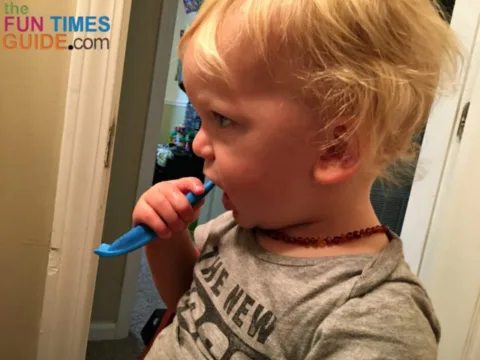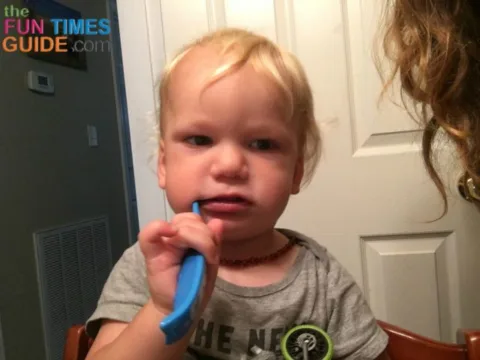My baby is now 16 months old and has already cut 12 teeth. Most babies will cut 20 baby teeth by the age of 3 — some do it by the age of 2.
See the order of appearance for baby teeth.
I started my baby’s oral care regime as soon as he got his first tooth. But I should have started even before his first baby teeth erupted through the gums.
I knew it was important to start an oral care routine as soon as possible, but I just never got serious about it until after he cut his first teeth. I wanted to be consistent in developing healthy habits early — to make for an easier transition when baby could start brushing on his own.
I definitely wanted my baby to be used to brushing his teeth every day — so he would understand that it’s just part of his daily routine when he’s older.
Our tooth brushing routine is simple, but not always easy — because we are sometimes dealing with a baby who isn’t in the mood to brush his teeth.
Today I’m going to show you how to brush baby teeth and our daily oral care routine…
When To Start Brushing Baby’s Teeth
The truth is you can start good oral care for your baby’s gums even before their teeth come in.
Here’s how to brush a baby’s gums:
Simply wipe your baby’s gums every day using a soft, warm, wet washcloth (or gauze) after each feeding throughout the day.
Like this:
There is actually a finger toothbrush for infants, too. Your baby might find the feeling of your finger on their gums soothing when they start to teethe.
Like this:
How To Brush Baby Teeth Daily
I always try to brush my toddler’s teeth at least twice a day and always during bath or shower time — because then it’s guaranteed to get done.
My baby really enjoys brushing his teeth in front of the mirror — so this is a helpful tactic in getting the job done while keeping it fun.
I got baby his own toothbrush with a nice grip on it. We really like the Koala Pals kids toothbrush from Melaleuca and their fun training tooth gel, which is apple flavored and fluoride-free. (Check with your dentist for help deciding which toothpaste your child should use.)
This is our routine:
- I wet his toothbrush first, and then put the tiniest smear of the training tooth gel on it.
- Next, I get my own toothbrush and toothpaste ready — so we can brush our teeth together, and he can watch how I brush my teeth. (Here’s my complete oral care routine for myself.)
- I always start by brushing his teeth the best I can while he gives me small opportunities to get the toothbrush inside his mouth.
- I brush very gently on the outside and inside of my baby’s teeth. If he lets me, I also softly run the bristles over his gums and tongue, too.
- From there, I let him take over and continue brushing as much as he likes — while trying to coax him to follow my lead while I brush my own teeth.
Wondering How Much Toothpaste To Use?…
The American Dental Association (ADA) emphasizes only the tiniest amount of fluoride toothpaste should be used to minimize the risk of mild discoloration, white spots, or streaking of the teeth — a condition called fluorosis that is caused by ingesting fluoride toothpaste at a young age. We want to minimize the amount of fluoride consumption to reduce the risk of fluorosis while simultaneously adding a preventive tool for kids 2 and under that we haven’t recommended previously. Only a tiny amount of toothpaste should be smeared on the brush since some youngsters are likely to ingest some of the fluoride. Source
How To Brush Baby Teeth When Baby Isn’t Cooperating
At times, when he is being less than cooperative, he will open and close his mouth, bite down on the brush, toss his head back, and try to block further brushing.
This is normal. I just remain patient, persistent, and encouraging — while trying to brush as many teeth and gums as I can.
If we are having an especially “not going as planned” nighttime routine, I will concede to:
- Wetting a small baby washcloth.
- Placing it around my finger.
- Adding a tiny smear of training tooth gel onto the tip.
- Quickly but gently rubbing it along baby’s teeth and gums.
This will at least knock out some of the bacteria before bed!
Bacteria in the mouth causes bad breath. It’s also important to loosen and remove the bacteria to prevent tooth decay.
Cavities can actually develop in baby teeth, too. I can’t imagine trying to get my baby to sit still and cooperate in a dentist’s chair, so brushing well and often is the norm in our household.
The Bottom Line…
I definitely want to take good care of my baby’s first set of pearly whites and gums.
I love his little smile and want to help him establish good dental habits for years to come.
Here are 10 things you should know about your tot’s teeth, according to the ADA.
In our video, you can see how my 16-month-old is already familiar with the teeth brushing routine:
I’m a new mom. I work from home and I write — mostly about my outdoor adventures, DIY projects, newly discovered products, and helpful tips as a first-time mom. I also like to share details about the alternative choices I’m exploring as I enjoy this journey called motherhood. My family includes a toddler, 2 stepchildren, 1 dog, 1 cat, and a wonderful husband. My pre-pregnancy life was full of freedom and adventure, so I have a fresh new perspective when it comes to walking away from a career to become a full time stay-at-home Mama.













